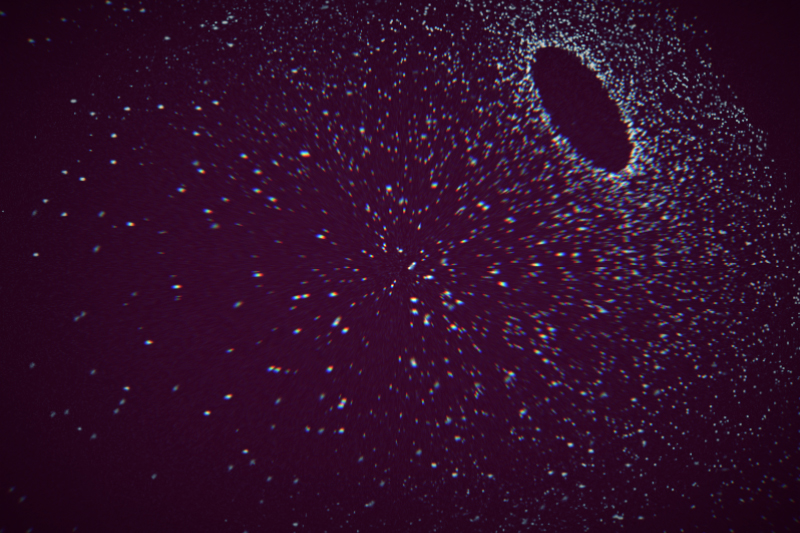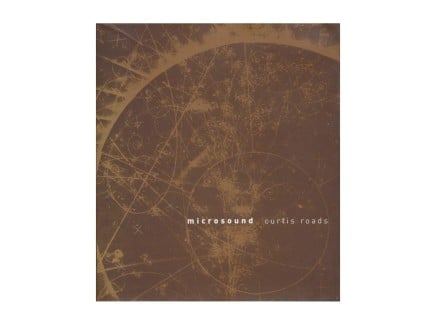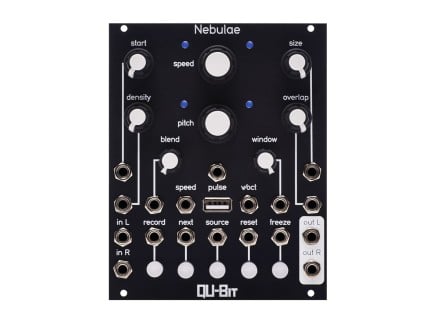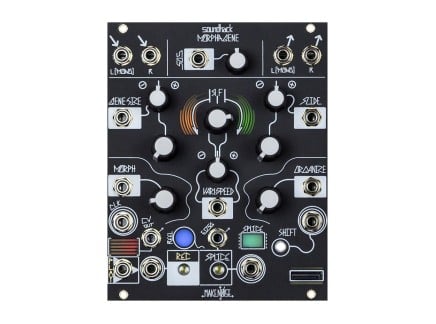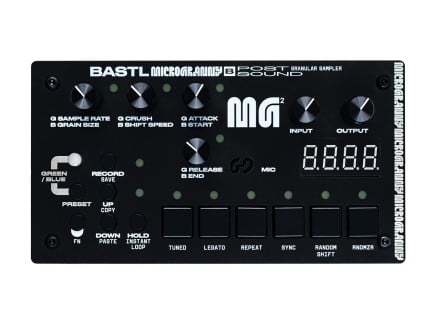In the recent years there has been an elevated interest in granular synthesis. No wonder such devices (let alone abundant software options) as Mutable Instruments Clouds, Make Noise Morphagene, QuBit Nebulae, Red Panda Particle develop almost a cult-like following around them. Any sounds processed through them, even the simplest ones, inevitably gain the potential to morph and endlessly mutate into an array of complex textures, scattered rhythmic patterns, thick drones or even full compositions. Timbral and tonal structures produced using granular processing are captivating and the potential for sonic diversity is immense. Granular techniques led to the evolution of new compositional methods as well as influencing whole genres of music. This is the landscape that we are going to be exploring within this article.
Origins
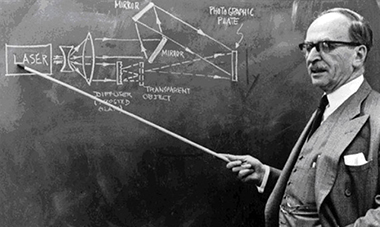
We often think of microsound as a fairly recent concept that found application through the domination of digital technologies, however the notion of using smaller-than-a-note elements in composition can be traced further back in history to modernist approaches proposed by the Köln and Darmstadt schools of composers. The technical evolution of the idea emerged from the 1947 research paper of the British-Hungarian physicist Dennis Gabor, titled “Acoustic quanta and the theory of hearing”. Gabor’s interest laid not in exploring the previously established ideas of physical acoustics, but the unattended during his time, subjective acoustics and human perception. Gabor suggested that beneath the plethora of well-established strata of sonic structures, there are layers of previously undiscovered microscopic sound particles that exist on the edges of and beyond our common discernment. To make sense of this microsonic universe through the limitations of human hearing mechanism, Gabor proposed that any sound phenomena can be disintegrated into sets of sound particles on a timescale from 1ms to 100ms. Gabor designated all sounds within this range as sound quanta, while everything else that occupies time scales below 1ms remains uninterpretable by the human perception apparatus.
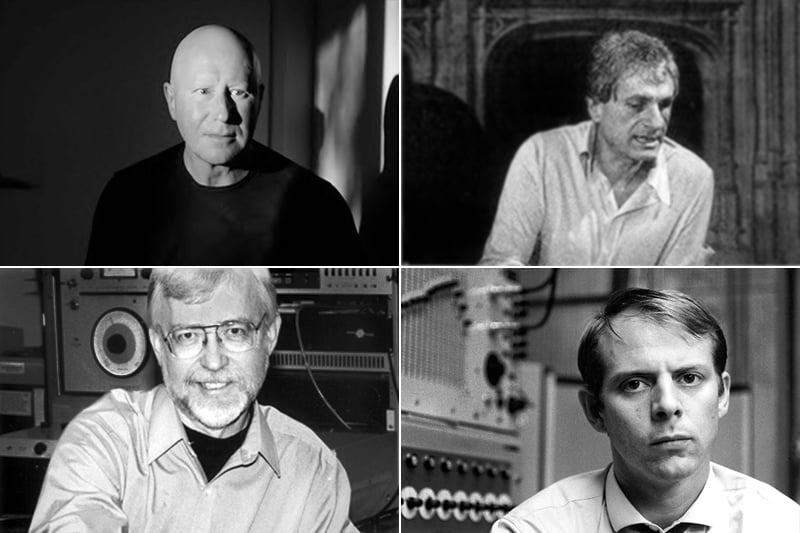
Though these ideas were incredibly important for the development of particle synthesis, they were initially applied within the field of psychoacoustics and not so much within the context of music. In fact, before computer technology, microsonic structures were hidden from us and generally unknown. Composing within the realm of microsound was spearheaded by the pioneers of electronic and electro-acoustic music Iannis Xenakis, Karlheinz Stockhausen, and Barry Truax. The methodology and techniques eventually were meticulously documented and explored in the research of the composer, programmer and professor at UCSB Curtis Roads, culminating in his magnum opus “Microsound” (2001), which we highly recommend as an in-depth guide to the subject.
Musical Time Scales
According to Roads, we can arrange musical events into nine hierarchical timescales that cross-interact within our perceptual boundaries. The topmost being the ‘Infinite’ - which can be conceived as an endless sine wave. Below is the level he calls ‘Supra’, which extends beyond individual composition and can be measured in months, years and even centuries. Further we get into the ‘Macro’ time scale confined by the entirety of the form of musical composition, that may lay anywhere within minutes, hours or days. Below is a ‘Meso’ scale, where the overall form gets subdivided into phrases, groups and sections that usually remain within limits of minutes or seconds. ‘Sound objects’ include everything on the time scale of notes and more complex sonic events extendable between the fractions of a second and several seconds. This is the time scale where what we know as granular clusters and clouds live. Beneath that is the ‘Micro’ level of individual sound particles that exist within the millisecond range and are delimited by the threshold of human perception. Lower is the level of individual binary ‘Samples’, expressed in microseconds. The nanosecond realm of ‘Subsamples’ gets very difficult even to accurately record, let alone perceive. At the bottom of the hierarchy is the ‘Infinitesimal’—the time scale of mathematical durations.
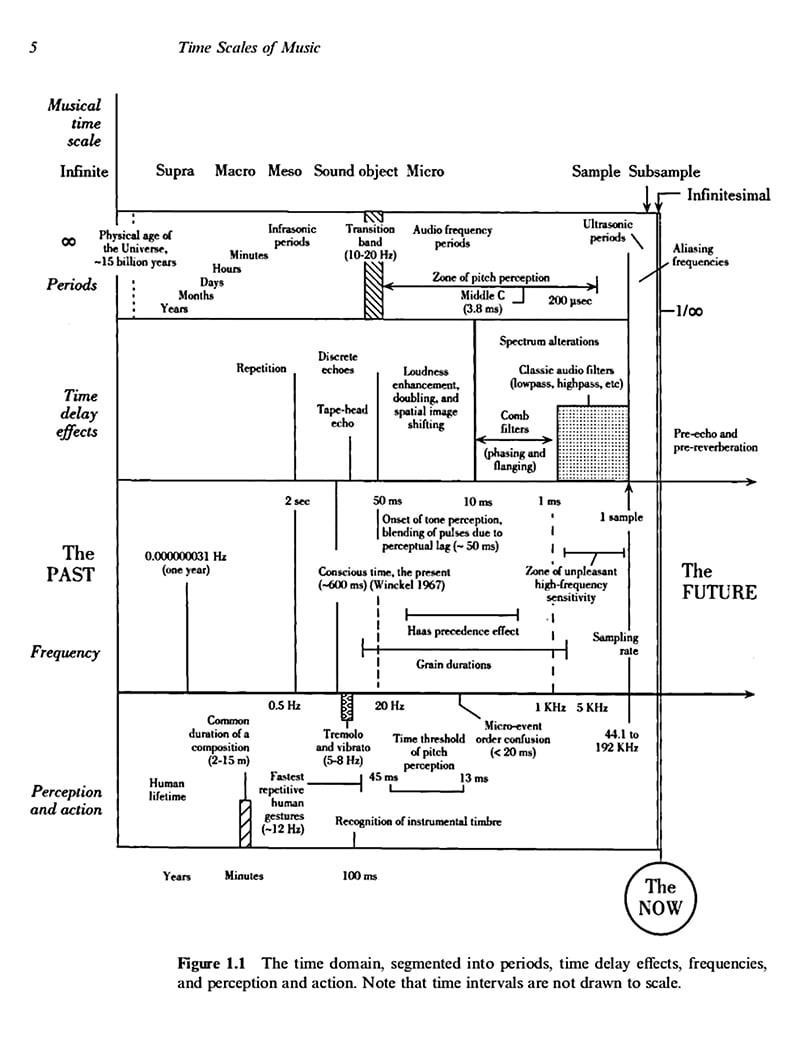
Sound travels between these timescales, sometimes overlapping or occupying all levels simultaneously. Although the waveform of the sound remains unchanged, our experience transforms drastically depending on what particular timescale we are observing. Thus, dealing even with the basic sine wave yields varied perceptual experiences whether on a sound object, macro, micro, sample or any other levels. This matters to us because composing within the microsound realm may lead to very different musical results and the techniques involved in the compositional process may also differ quite a bit from dealing with regular sonic suspects of traditional music. As Roads points out in his book, it is essential for one to adopt the widest possible definition of music to engage with the universe of composition using sound particles.
General Description of Particle Synthesis Elements and Parameters
Synchronous vs asynchronous generation of grains
The synchronicity of a granular engine has to do with the ways of temporal distribution of sound particles. Some type of variable-rate clock is implemented in every granular system—either internally, by means of a dedicated input for an external source, or both. In case of a synchronous granular synthesis - clocking is implemented globally, as grains are separated by an equal time gap. The asynchronous method allows particles to be reordered and triggered non-linearly, often by means of random modulation. The general parametrization for both methods is quite similar.
Grain is a basic building block of larger sound objects that, when generated amass, aids to the formations of complex sonic textures. Grains are represented within the frequency domain as the pitch of the waveform, and in the time domain as grain duration, start time or envelope shape.
Grain duration defines the size of individual sound particles. Alternatively, the term grain size may be used.
Start time or phase indicates the position of the playhead within the grain.
Grain density is the amount of particles generated per second. The parameter sorts out the overall distribution of grains within the cloud, i.e. packed close together or spread apart. Density is interrelated with the grain duration as the more particles are generated, the more overlaps between them are happening. The denser the texture, the richer the timbral qualities of the sound, while sparse distribution of grains yields more rhythmic results.
Inter-onset time sets the gap time between the grains, either for all as in synchronous engines, or through application of random modulation of the parameter in asynchronous ones. This parameter is also often called spray.
Pitch describes the frequency of individual grains, accomplished by playing them back at different sample rates, and in synchronous engines is tightly connected with the density parameter.
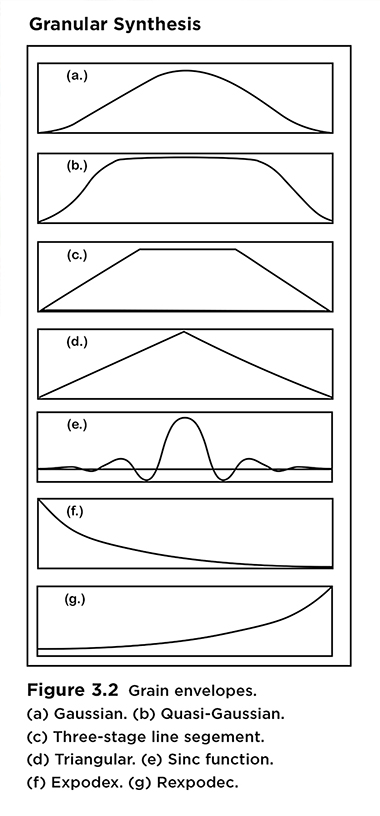
Grain shape is expressed through the various types of envelope functions applied to the amplitude of sound particles. Typical envelope shapes used are gaussian, quasi-gaussian, triangular, three-stage line segment, sinc function, expodec and rexpodec. Each of these envelope functions expectedly yields very different timbral and temporal results.
Amplitude refers to a macro parameter responsible for the overall loudness of the texture.
It is worth mentioning here that, although the naming convention for the parametrization of granular synthesizers is established and applied throughout, often alternative labels take place solely determined by the designer/manufacturer. For example, in Make Noise Morphagene start time is labeled as slide, gene size controls the size of grains, and morph acts as a sort of macro knob for specifying grain density, inter-onset time, spatialization, and pitch in the form randomly generated octaves and fifths. In case of the Mutable Instruments Clouds module, position knob sets the grain start time, and density not only defines the amount of particle distribution, but also alters the synchronicity (though presently discontinued, the open-source nature of the device manifests in many reincarnations through miniature µBurst, expanded Supercell, and other variations). Also, grain amplitude envelope is very often missing as a user definable parameter, however Qu-Bit Nebulae makes it accessible through the knob labeled window.
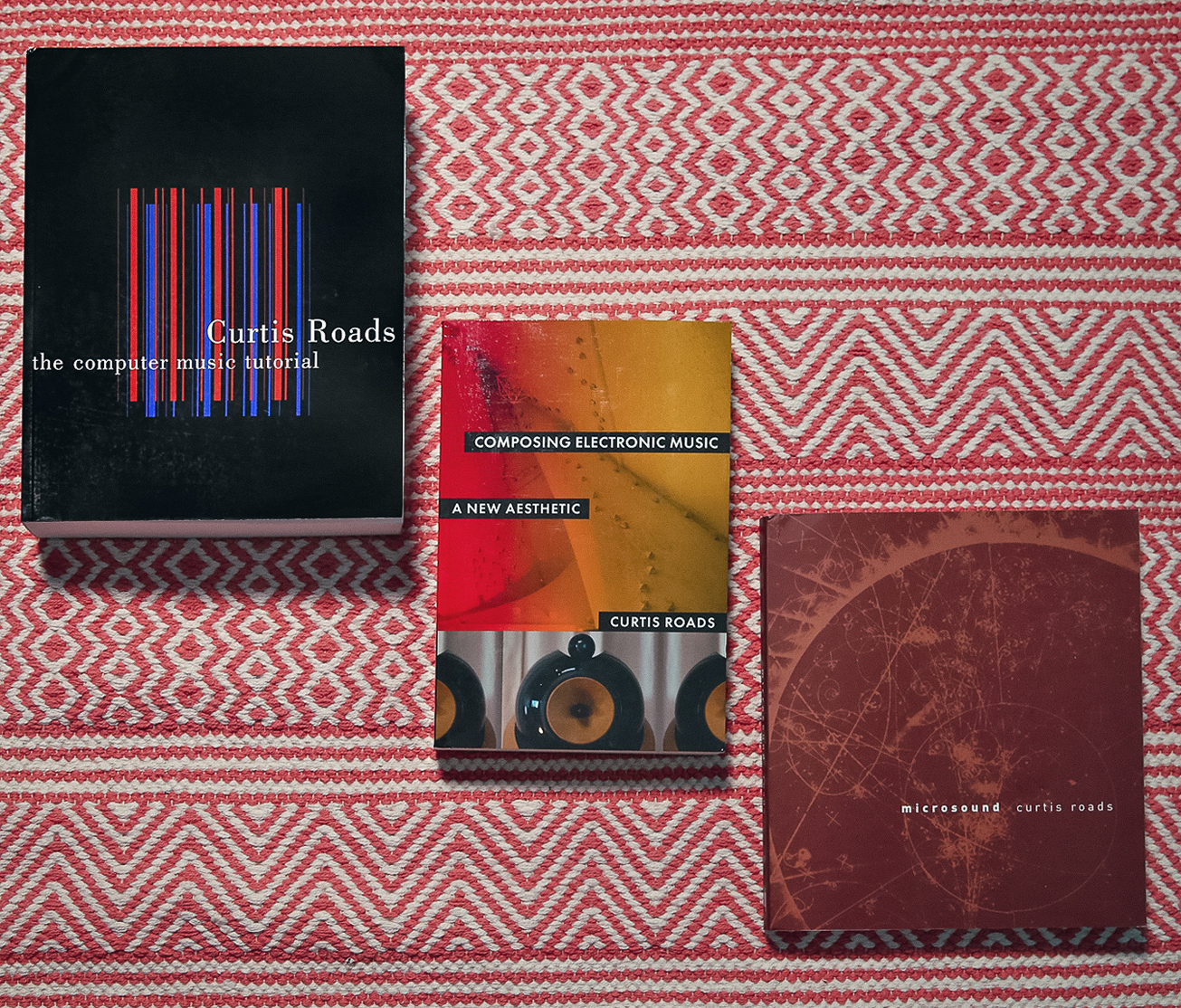
Particle Synthesis Techniques
The term particle sound synthesis serves as a macro description of many possible ways to manipulate microsonic content. In this section we will be exploring fundamental concepts and general differences between the various sub-branches.
Granular Synthesis is the most fundamental technique upon which all the other ones are derived from. Any sampled or periodic waveform will suffice as it is disassembled into microscopic sound particles ranging from 1ms to 100ms. Parametrization is expressed through the already familiar grain shape, grain duration, grain density, start time and pitch.
Glisson Synthesis is very similar to the basic granular synthesis technique, however the method requires an additional frequency path to be implemented within grains for glissando-like effects. This requires frequency start and frequency end parameters along with definable trajectory curvature settings.
Grainlet Synthesis is somewhat a hybrid of basic granular and wavelet synthesis types. Wavelets are essentially very short wave-like oscillations. Unlike with grains, the duration of a wavelet is inversely linked to its frequency. In grainlet synthesis this inverse relationship is exploited on a broader scale by creating various linked combinations of synthesizer parameters, i.e. space/duration, frequency/space, frequency/duration, amplitude/space, etc. As you may notice, this calls for an additional parameter for positioning the grainlet in a spatial field. It is also worth noting that it is possible to create linkages between more than just two parameters.
Trainlet Synthesis differs from the rest specifically by the content of the grain waveform, which in this case is a live-synthesized band-limited impulse train, rather than a sampled or periodic waveform. We define a trainlet by its attack time, pulse period (or frequency if at audio rate), harmonic structure (or spectra) and the relationship between high and low harmonic content, known as harmonic balance (or chroma). The rest of the parameters are identical to the previously described variations of particle synthesis.
Pulsar Synthesis is a technique aided by the concept commonly found in classic analog synthesis, namely a waveform’s duty cycle, however in this case it is applicable to any arbitrary waveform, not just square waves,. Pulsar is formed by the combination of a pulsaret (a brief band-limited impulse signal) followed by a short segment of silence. The duration of the pulsaret is what makes up the duty cycle of the signal, while the duration of the pulsar itself is expressed as the pulsar period. A repeated series of pulsars creates a pulsar train. As any waveform can potentially be used as a source for the pulsaret, varying duty cycles are achieved by applying envelopes to the amplitude of the pulsaret, which in effect also alters the spectrum of the signal. The interconnected relationship between the pulsaret and silence is crucial as it facilitates the dynamic cross-transformation between rhythmic and tonal content of the same signal. Grain masking is another unique feature of the pulsar synthesis, usually achieved by random or periodic amplitude variations of individual pulsarets within the pulsar.
Formant Synthesis is a method of generating sounds that possess timbral qualities reminiscent of vocal vowels and some traditional music instruments. By technical definition, formant is a peak energy of the spectrum that contains both harmonic and inharmonic partials as well as noise. Within the context of microsonic synthesis techniques we know of a few developed frameworks—FOF (formant wave function), VOSIM and window function synthesis. All of these methods utilize generation and manipulation of streams of grains to achieve formant effects, however it would be beyond the scope of this article to dive deeper into each one of them.
Microsonic Tools
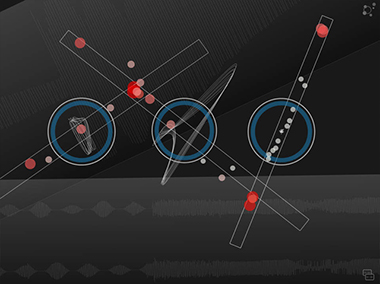 Borderlands Ipad app by Chris Carlson
Borderlands Ipad app by Chris Carlson
As with anything that transcends beyond our humanly instruments of detection, in order to discern and manipulate tiny sound particles, singularly or in groups, we need special instruments, akin to a microscope. Various dedicated software and hardware units were and are developed to do just that.
While Xenakis had to subsist with the technology of his time—primarily utilizing analog oscillators and meticulous tape splicing techniques, particle synthesis found so much resonance, that nowadays extremely powerful granular tools like Borderlands are available via tablet. Roads also developed early granular software tools, which are still available today - Cloudgenerator and Pulsargenerator (unfortunately, only for Mac OS9).
It is very much worth noting several development platforms that are superbly powerful and flexible for working with particle sound synthesis -MAX/MSP, Reaktor, Supercollider, Csound, Pure Data and Chuck. The world of hardware synthesizers also gets lots of granular attention ranging from compact and perky Micro Granny 2.0 by Bastl Instruments to remarkably deep GR-1 by Tasty Chips.
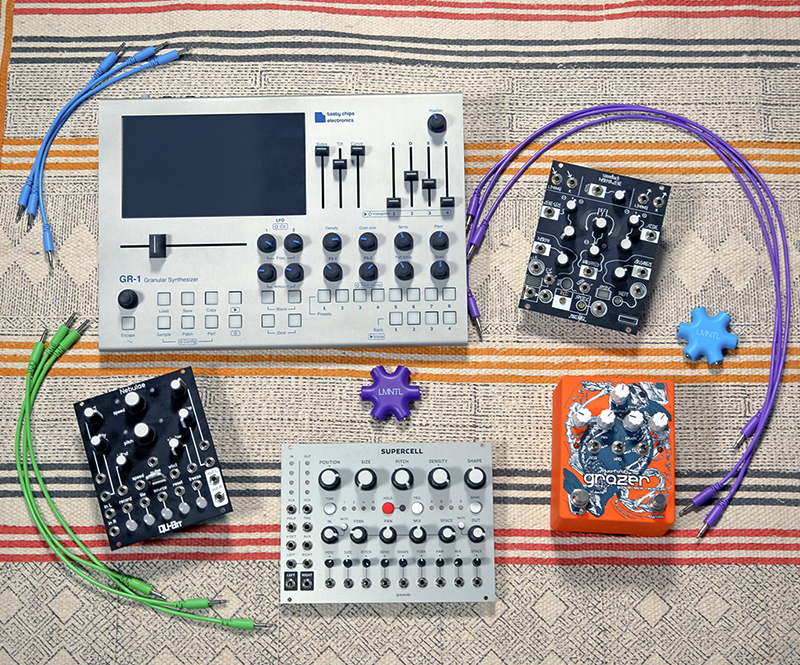
The Music of Microsound
Evidently, since early experiments of pioneer composers a lot has changed both culturally and technologically. Though various pieces of software and hardware that utilize particle synthesis are not genre specific and mesmerizing granular textures can be found even in the depth of layers of popular music, microsound as a compositional framework continues its evolution as in academic environments, and in forms of electronic music sub-culture, where it overlaps with such genres as ambient, lowercase, noise, and even techno. There are several modern record labels that consistently release microsound recordings, notably 12K, Raster Media, Room40, Line, Mille Plateaux, Editions Mego, Touch, etc. As music is better understood through direct listening, rather than reading about it, we’ve prepared a Spotify playlist to accompany this article. Please enjoy!

